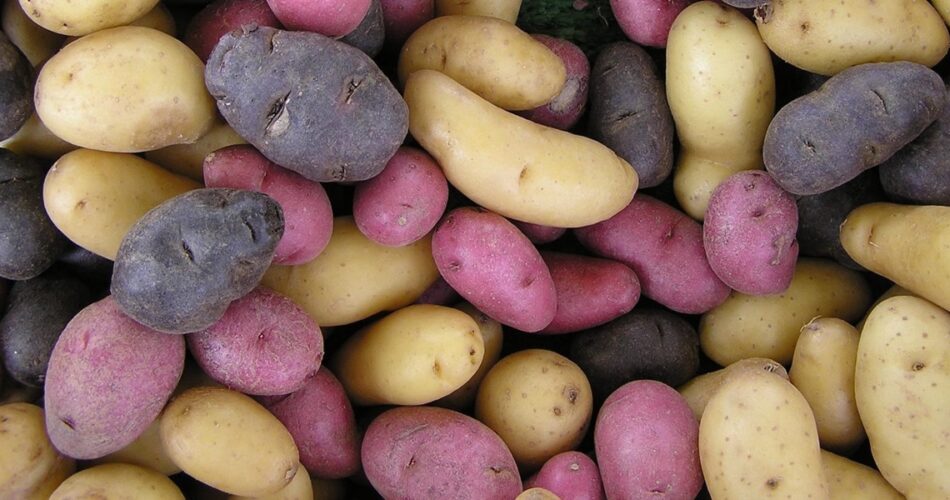Potatoes are a versatile and rewarding crop to grow in your garden, offering a wide range of flavors, textures, and culinary possibilities. In this expert guide, we explore 10 types of potatoes that you should consider cultivating, providing insights from horticultural experts and referencing reputable sources.
Russet Burbank (Solanum tuberosum ‘Russet Burbank’)
Russet Burbank potatoes are a classic choice for growers, known for their large size, high starch content, and versatility in the kitchen. According to the United States Department of Agriculture (USDA), Russet Burbank is one of the most widely grown potato varieties in the United States, prized for its excellent baking and frying qualities.

Yukon Gold (Solanum tuberosum ‘Yukon Gold’)
Yukon Gold potatoes are beloved for their buttery flavor, creamy texture, and golden-yellow flesh. Horticultural experts recommend Yukon Gold for its versatility in cooking, from boiling and mashing to roasting and frying. The University of Maine Cooperative Extension provides valuable insights into the cultivation and care of Yukon Gold potatoes, highlighting their adaptability to various soil types and growing conditions.
Red Pontiac (Solanum tuberosum ‘Red Pontiac’)
Red Pontiac potatoes are prized for their vibrant red skin, firm texture, and rich flavor. According to the National Gardening Association, Red Pontiac is a popular choice for gardeners due to its high yield and resistance to common potato diseases. References to Red Pontiac cultivation tips and best practices can be found in publications by agricultural extension services and gardening experts.
Fingerling Potatoes (Various Solanum tuberosum Cultivars)
Fingerling potatoes encompass a diverse group of small, elongated tubers with a waxy texture and unique flavors. Varieties such as Russian Banana, French Fingerling, and Purple Peruvian offer gardeners a delightful array of colors and tastes. The Royal Horticultural Society (RHS) provides guidance on growing fingerling potatoes, emphasizing the importance of well-drained soil and adequate moisture levels.
Purple Majesty (Solanum tuberosum ‘Purple Majesty’)
Purple Majesty potatoes are prized for their striking deep purple skin and vibrant purple flesh, which contains high levels of antioxidants. According to research published in the Journal of Agricultural and Food Chemistry, Purple Majesty potatoes exhibit potent antioxidant properties, making them a nutritious addition to the diet. The Colorado State University Extension offers recommendations for growing Purple Majesty potatoes in home gardens, highlighting their potential health benefits and culinary uses.
Kennebec (Solanum tuberosum ‘Kennebec’)
Kennebec potatoes are renowned for their smooth skin, uniform shape, and excellent storage qualities. The University of Idaho Extension recommends Kennebec as a reliable choice for both home gardeners and commercial growers, citing its resistance to common potato pests and diseases. Resources from university extension programs and agricultural research institutions offer valuable insights into Kennebec cultivation techniques and pest management strategies.
All Blue (Solanum tuberosum ‘All Blue’)
All Blue potatoes, also known as Purple Peruvian or Blue Congo, feature striking blue or purple skin and flesh, adding a vibrant pop of color to culinary dishes. According to the University of California Cooperative Extension, All Blue potatoes are high in anthocyanins, which have been linked to various health benefits. Gardening publications and horticultural societies provide guidance on growing All Blue potatoes, highlighting their unique appearance and culinary uses.
German Butterball (Solanum tuberosum ‘German Butterball’)
German Butterball potatoes are prized for their golden-yellow skin, buttery flavor, and creamy texture, making them a favorite among chefs and home cooks alike. The Organic Seed Alliance offers resources on organic potato production, including information on German Butterball cultivation practices and seed sourcing. References to German Butterball cultivation can also be found in publications by organic gardening experts and sustainable agriculture organizations.
Adirondack Blue (Solanum tuberosum ‘Adirondack Blue’)
Adirondack Blue potatoes feature vibrant blue-purple skin and bright white flesh, adding a colorful twist to culinary creations. According to Cornell University’s College of Agriculture and Life Sciences, Adirondack Blue potatoes are rich in antioxidants and can be grown successfully in home gardens with proper care. Extension publications from land-grant universities provide guidance on Adirondack Blue cultivation, including soil preparation, planting, and harvesting tips.
Katahdin (Solanum tuberosum ‘Katahdin’)
Katahdin potatoes are known for their smooth, thin skin, creamy flesh, and excellent boiling and baking qualities. The Maine Potato Board offers resources on Katahdin potato production, highlighting its importance as a staple crop in the state’s agricultural economy. References to Katahdin cultivation techniques can be found in publications by agricultural extension services and potato research organizations.
Conclusion: Cultivating a Bounty of Potatoes
In conclusion, growing potatoes in your garden offers a rewarding experience and the opportunity to enjoy a diverse array of flavors, colors, and textures. By exploring different potato varieties and following expert guidance on cultivation practices, you can cultivate a bountiful harvest of delicious tubers to savor and share with family and friends.
- Explore THC Infused Drinks in New York - May 9, 2025
- The Latest in THC Seltzers Across Texas - May 9, 2025
- Top THC Infused Drinks Available in Oklahoma - May 9, 2025




